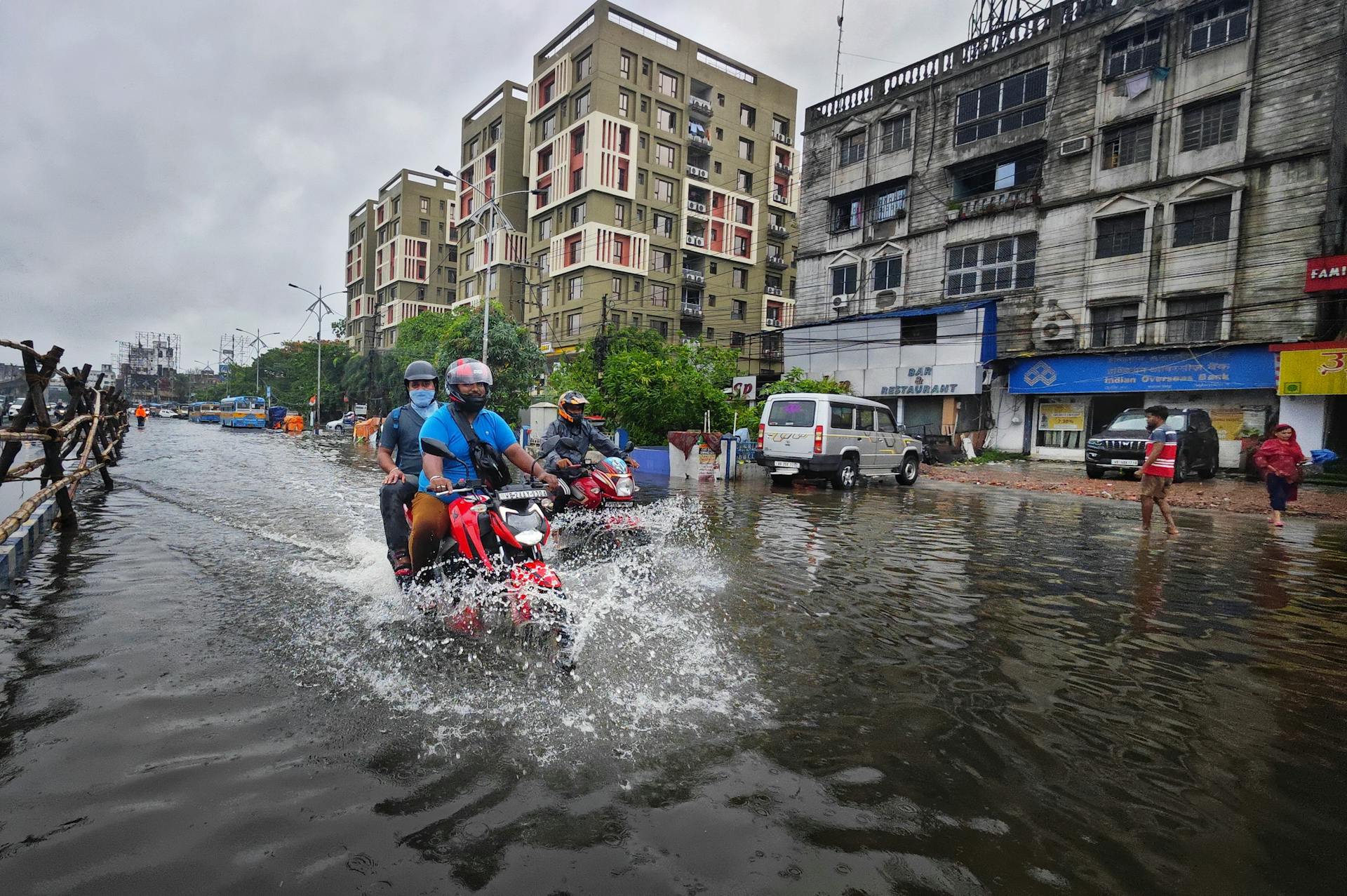
Navigating the flood insurance claim process can be overwhelming, but having the right information can make a big difference.
The first step in the flood insurance claim process is to report the damage to your insurance company as soon as possible, ideally within 60 days of the flood event.
You'll need to provide detailed documentation of the damage, including photos and videos, to support your claim. This will help the insurance company assess the extent of the damage.
The insurance company will then assign an adjuster to inspect the property and determine the extent of the damage. The adjuster will review your policy and assess the damage to your property.
The adjuster's report will outline the damages and the amount of the claim, which will be paid out according to your policy's terms.
For your interest: Does Renter Insurance Cover Flood Damage
Filing a Claim
Filing a claim is the first step in getting your flood insurance benefits. Contact your flood insurer as soon as possible to initiate the paperwork and adjustor's visit.
You might like: What Does Flood Insurance Not Cover
You typically have up to 60 days after a flood to file your claim, but it's best not to delay communicating with your insurance company. Letting your insurer know about damage gets you the paperwork you need to move forward and helps ensure a covered claim is paid out quickly.
To file a claim, you'll need to contact your insurance provider as soon as possible after the flood has occurred. This will notify the insurance company of the flood event and begin the documentation process.
Your policy number and personal identification information will be required for the initial contact. If your policy is through the National Flood Insurance Program, you'll need to contact them directly.
You can access the necessary claim forms through your insurance company's website or by contacting your agent. The forms will typically include your policy number, contact information, a detailed description of the damage, and an estimate of the repair or replacement costs.
To avoid common mistakes, be meticulous when filling out the forms and provide all requested information. Double-check all entries for completeness and correctness, and ensure all sections of the form are filled out and that you have included all required documents.
Here are the key documents you'll need to submit with your claim forms:
- Policy number
- Contact information
- Detailed description of the damage
- Estimate of repair or replacement costs
- Photos and videos of the affected areas
- Inventory list
- Proof of purchase or receipts for high-value items
Once your claim forms and supporting documents are complete, submit them to your insurance company using the most convenient method for you.
The Claim Process
The claim process for flood insurance can seem overwhelming, but understanding the steps involved can make it more manageable.
You typically have up to 60 days after a flood to file your claim, so it's essential to contact your flood insurance company as soon as possible to initiate the paperwork and get the process started.
Before you do anything, call your flood insurance company and alert them about the water damage to your home. This will trigger the formal claims process and ensure your insurer knows the situation.
You should also give your mortgage provider a call, as the settlement for your claim may be paid out to both you and your mortgage company, depending on the terms of your mortgage.
The claims adjuster will assess your property losses, typically by walking around your property and looking at what was destroyed or needs repair. They might also use a tool called a moisture meter to determine how high the floodwaters rose in your home.
Take a look at this: How to Become a Fema Claims Adjuster
Keep damaged items available for the adjuster to review, and take pictures or videos of them if you must get rid of items for safety purposes. This documentation can help the adjuster make the right decisions about your claim.
Your adjuster will compile a report that will be sent to your insurance company for review, and you'll receive a settlement offer outlining the amount your insurance company is willing to pay. Review this offer carefully to ensure it covers all the documented damages.
If you believe the offer is insufficient, you have the right to negotiate with the adjuster to submit an insurance claim.
Discover more: How to Value Items for Insurance Claim
Understanding Your Policy
Understanding your policy is crucial to navigating the flood insurance claim process smoothly. Familiarize yourself with the specific terms of your policy to understand what is covered and what might be excluded.
Pay attention to exclusions, such as damage caused by mold or long-term neglect, to avoid surprises. These exclusions can significantly impact the outcome of your claim.
Review your policy carefully to set realistic expectations for your compensation. This knowledge will help you file an accurate claim.
If there are ambiguities in your policy, seek clarification from your insurance agent. They can provide guidance on the policy's terms and conditions.
Final Steps
Staying organized is key to a successful claim, so make sure to document everything thoroughly.
To navigate the flood insurance claims process effectively, understanding your policy is crucial.
Maintaining open communication with your insurance provider is essential, so don't hesitate to reach out if you have any questions or concerns.
Knowing how to follow up on your claim is also important, in case you need to appeal if your claim is denied.
By following these steps, you can confidently navigate the complexities of filing your insurance claim and secure the compensation needed to recover and rebuild after a flood.
Preparation and Prevention
Before a flood hits, it's essential to have a plan in place to minimize damage and ensure a smooth claims process.
Take photos and videos of your property and belongings before the flood to document their condition, which can help support your insurance claim.
Having a flood emergency kit with essentials like food, water, and a first aid kit can help you stay safe and comfortable during the disaster.
The National Flood Insurance Program (NFIP) recommends that you elevate electrical outlets, switches, and any other electrical components at least 12 inches above the projected flood elevation.
Regularly inspect your property's drainage system to ensure it's functioning properly and can handle heavy rainfall.
Discover more: Personal Property Insurance Claim
Frequently Asked Questions
Which of the following is required after a flood loss?
After a flood loss, you must file your Proof of Loss with your insurance company within 60 days. This document is required to receive your claim payment.
How much will FEMA pay for flood damage?
FEMA's maximum individual grant for flood damage is $42,500, but the average payout is around $3,000. If you're affected by a flood, learn more about the FEMA grant process and eligibility requirements.
How to get the most from a flood insurance claim?
To maximize your flood insurance claim, verify the adjuster's identity and keep detailed records of all interactions with the insurance company. Consider consulting a flood insurance attorney for expert guidance and to ensure you receive the full benefits of your policy.
Sources
- https://www.statefarm.com/claims/home-and-property
- https://krapflegal.com/recources/water-damage/7-tips-when-filing-a-home-insurance-claim-for-water-damage/
- https://www.kin.com/blog/flood-claims-process/
- https://uphelp.org/claim-guidance-publications/flood-insurance-claim-basics/
- https://www.forbes.com/sites/truetamplin/2024/06/24/how-to-file-your-flood-insurance-claim-a-step-by-step-guide/
Featured Images: pexels.com


